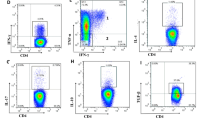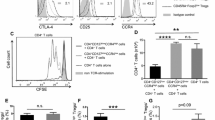Abstract
Background
For head and neck squamous cell cancer (HNSCC), standard therapy consists of surgery, radiation, and/or chemotherapy. Antineoplastic immunotherapy could be an option in an adjuvant setting and is already in palliation. A functional immune system is a prerequisite for successful immunotherapy. However, effects of the standard-of-care therapy on the patients’ immune system are not fully understood.
Methods
Peripheral blood mononuclear cells (PBMC) were collected from patients with HNSCC (n = 37) and healthy controls (n = 10). PBMC were stimulated with staphylococcal enterotoxin B (SEB). Simultaneous expression of various cytokines was measured in CD4+ and CD8+ T cells by multicolor flow cytometry, and polyfunctional cytokine expression profiles were determined on a single-cell basis.
Results
Expression levels of all measured cytokines in CD4+ T cells were higher in patients after chemoradiotherapy (CRT) as compared to untreated HNSCC patients or normal controls. After CRT, the frequency of polyfunctional CD4+ T cells, which simultaneously expressed multiple cytokines, was significantly increased as compared to untreated patients (p < 0.01).
Conclusion
CRT increases polyfunctionality of CD4+ T cells in HNSCC patients, suggesting that standard-of-care therapy can promote immune activity in immune cells. These polyfunctional CD4+ T cells in the blood of treated HNSCC patients are expected to be responsive to subsequent immunotherapeutic approaches.
Zusammenfassung
Hintergrund
Die Standardtherapie für Plattenepithelkarzinome im Kopf-Hals-Bereich (HNSCC) beinhaltet chirurgische Verfahren, Strahlentherapie und/oder Chemotherapie. Seit Kurzem ist eine Immuntherapie als zusätzliche palliative Therapieoption verfügbar und könnte auch in der adjuvanten Therapie nach primärer Chirurgie angewandt werden. Ein funktionierendes Immunsystem ist hierbei eine Grundvoraussetzung. Allerdings sind die Auswirkungen der herkömmlichen Therapien auf das Immunsystem noch nicht vollständig klar und bedürfen weiterer Untersuchungen.
Methoden
Es wurden periphere Monozyten („peripheral blood mononuclear cells“, PBMC) aus dem Blut von HNSCC-Patienten (n = 37) und gesunden Probanden (n = 10) zu unterschiedlichen Zeitpunkten isoliert. Zunächst wurden PBMCs mit Staphylokokken-Enterotoxin B (SEB) stimuliert. Anschließend wurde die Expression der Zytokine in CD4+ und CD8+ T‑Zellen mittels Mehrfarben-Durchflusszytometrie gemessen. Die Expressionsprofile und Polyfunktionalität wurden auf Einzelzellbasis ermittelt.
Ergebnisse
Die Expression aller gemessenen Zytokine in CD4+ T‑Zellen war für Patienten nach Radiochemotherapie höher, als für unbehandelte Patienten und gesunde Probanden. Die Polyfunktionalität der CD4+ T‑Zellen, also die Anzahl gleichzeitig exprimierter Zytokine, war nach Radiochemotherapie im Vergleich zu unbehandelten Patienten signifikant erhöht (p < 0,01).
Schlussfolgerung
Eine Steigerung der Polyfunktionalität von CD4+ T‑Lymphozyten nach Radiochemotherapie legt die Vermutung nahe, dass die Standardtherapie die Aktivität von Immunzellen fördert. Es ist daher gut möglich, dass diese polyfunktionalen CD4+ T‑Zellen auf eine nachfolgende Immuntherapie ansprechen könnten.




Similar content being viewed by others
References
Levy A, Blanchard P, Bellefqih S, Brahimi N, Guigay J, Janot F, Temam S, Bourhis J, Deutsch E, Daly-Schveitzer N, Tao Y (2014) Concurrent use of cisplatin or cetuximab with definitive radiotherapy for locally advanced head and neck squamous cell carcinomas. Strahlenther Onkol 190(9):823–831. https://doi.org/10.1007/s00066-014-0626-0
Chow LQ, Haddad R, Gupta S, Mahipal A, Mehra R, Tahara M, Berger R, Eder JP, Burtness B, Lee SH, Keam B, Kang H, Muro K, Weiss J, Geva R, Lin CC, Chung HC, Meister A, Dolled-Filhart M, Pathiraja K, Cheng JD, Seiwert TY (2016) Antitumor activity of pembrolizumab in biomarker-unselected patients with recurrent and/or metastatic head and neck squamous cell carcinoma: results from the phase Ib KEYNOTE-012 expansion cohort. J Clin Oncol. https://doi.org/10.1200/jco.2016.68.1478
Popp I, Grosu AL, Niedermann G, Duda DG (2016) Immune modulation by hypofractionated stereotactic radiation therapy: therapeutic implications. Radiother Oncol 120(2):185–194. https://doi.org/10.1016/j.radonc.2016.07.013
Baumann R, Dunst J (2017) Radiotherapy enhances the effect of PD-1 checkpoint inhibitors. Strahlenther Onkol. https://doi.org/10.1007/s00066-017-1179-9
Zhang P, Su DM, Liang M, Fu J (2008) Chemopreventive agents induce programmed death-1-ligand 1 (PD-L1) surface expression in breast cancer cells and promote PD-L1-mediated T cell apoptosis. Mol Immunol 45(5):1470–1476. https://doi.org/10.1016/j.molimm.2007.08.013
Ghadjar P, Pöttgen C, Joos D, Hayoz S, Baumann M, Bodis S, Budach W, Studer G, Stromberger C, Zimmermann F, Kaul D, Plasswilm L, Olze H, Bernier J, Wust P, Aebersold DM, Budach V (2016) Haemoglobin and creatinine values as prognostic factors for outcome of concurrent radiochemotherapy in locally advanced head and neck cancers. Strahlenther Onkol 192(8):552–560. https://doi.org/10.1007/s00066-016-0999-3
De Rosa SC, Lu FX, Yu J, Perfetto SP, Falloon J, Moser S, Evans TG, Koup R, Miller CJ, Roederer M (2004) Vaccination in humans generates broad T cell cytokine responses. J Immunol 173((9):5372–5380
Makedonas G, Betts MR (2006) Polyfunctional analysis of human t cell responses: importance in vaccine immunogenicity and natural infection. Springer Semin Immunopathol 28(3):209–219. https://doi.org/10.1007/s00281-006-0025-4
Laban S, Doescher J, Schuler PJ, Bullinger L, Brunner C, Veit JA, Hoffmann TK (2015) Immunotherapy of head and neck tumors: highlights of the ASCO Meeting 2015. HNO 63(9):612–619. https://doi.org/10.1007/s00106-015-0054-1
Schuler PJ, Harasymczuk M, Schilling B, Lang S, Whiteside TL (2011) Separation of human CD4+CD39+ T cells by magnetic beads reveals two phenotypically and functionally different subsets. J Immunol Methods 369(1–2):59–68. https://doi.org/10.1016/j.jim.2011.04.004
Schuler PJ, Schilling B, Harasymczuk M, Hoffmann TK, Johnson J, Lang S, Whiteside TL (2012) Phenotypic and functional characteristics of CD4+ CD39+ FOXP3+ and CD4+ CD39+ FOXP3neg T‑cell subsets in cancer patients. Eur J Immunol 42(7):1876–1885. https://doi.org/10.1002/eji.201142347
Schuler PJ, Harasymczuk M, Schilling B, Saze Z, Strauss L, Lang S, Johnson JT, Whiteside TL (2013) Effects of adjuvant chemoradiotherapy on the frequency and function of regulatory T cells in patients with head and neck cancer. Clin Cancer Res 19(23):6585–6596. https://doi.org/10.1158/1078-0432.ccr-13-0900
Lissoni P, Brivio F, Fumagalli L, Messina G, Meregalli S, Porro G, Rovelli F, Vigore L, Tisi E, D’Amico G (2009) Effects of the conventional antitumor therapies surgery, chemotherapy, radiotherapy and immunotherapy on regulatory T lymphocytes in cancer patients. Anticancer Res 29(5):1847–1852
Schmidt MA, Fortsch C, Schmidt M, Rau TT, Fietkau R, Distel LV (2012) Circulating regulatory T cells of cancer patients receiving radiochemotherapy may be useful to individualize cancer treatment. Radiother Oncol 104(1):131–138. https://doi.org/10.1016/j.radonc.2012.05.003
Agarwal A, Rani M, Saha GK, Valarmathi TM, Bahadur S, Mohanti BK, Das SN (2003) Disregulated expression of the Th2 cytokine gene in patients with intraoral squamous cell carcinoma. Immunol Invest 32(1–2):17–30
Schoenborn JR, Wilson CB (2007) Regulation of interferon-gamma during innate and adaptive immune responses. Adv Immunol 96:41–101. https://doi.org/10.1016/s0065-2776(07)96002-2
Ikeda H, Old LJ, Schreiber RD (2002) The roles of IFNγ in protection against tumor development and cancer immunoediting. Cytokine Growth Factor Rev 13(2):95–109. https://doi.org/10.1016/S1359-6101(01)00038-7
Katayama A, Ogino T, Bandoh N, Nonaka S, Harabuchi Y (2005) Expression of CXCR4 and its down-regulation by IFN-gamma in head and neck squamous cell carcinoma. Clin Cancer Res 11(8):2937–2946. https://doi.org/10.1158/1078-0432.ccr-04-1470
Yannelli JR, Tucker JA, Hidalgo G, Perkins S, Kryscio R, Hirschowitz EA (2009) Characteristics of PBMC obtained from leukapheresis products and tumor biopsies of patients with non-small cell lung cancer. Oncol Rep 22(6):1459–1471
Hoffmann TK, Sonkoly E, Homey B, Scheckenbach K, Gwosdz C, Bas M, Chaker A, Schirlau K, Whiteside TL (2007) Aberrant cytokine expression in serum of patients with adenoid cystic carcinoma and squamous cell carcinoma of the head and neck. Head Neck 29(5):472–478. https://doi.org/10.1002/hed.20533
Taniguchi K, Karin M (2014) IL‑6 and related cytokines as the critical lynchpins between inflammation and cancer. Semin Immunol 26(1):54–74. https://doi.org/10.1016/j.smim.2014.01.001
Dong C (2008) TH17 cells in development: an updated view of their molecular identity and genetic programming. Nat Rev Immunol 8(5):337–348. https://doi.org/10.1038/nri2295
Duffy SA, Taylor JM, Terrell JE, Islam M, Li Y, Fowler KE, Wolf GT, Teknos TN (2008) Interleukin-6 predicts recurrence and survival among head and neck cancer patients. Cancer 113(4):750–757. https://doi.org/10.1002/cncr.23615
Macchia I, Urbani F, Proietti E (2013) Immune monitoring in cancer vaccine clinical trials: critical issues of functional flow cytometry-based assays. Biomed Res Int. https://doi.org/10.1155/2013/726239
Yuan J, Gnjatic S, Li H, Powel S, Gallardo HF, Ritter E, Ku GY, Jungbluth AA, Segal NH, Rasalan TS, Manukian G, Xu Y, Roman RA, Terzulli SL, Heywood M, Pogoriler E, Ritter G, Old LJ, Allison JP, Wolchok JD (2008) CTLA-4 blockade enhances polyfunctional NY-ESO-1 specific T cell responses in metastatic melanoma patients with clinical benefit. Proc Natl Acad Sci USA 105(51):20410–20415. https://doi.org/10.1073/pnas.0810114105
Betts MR, Nason MC, West SM, De Rosa SC, Migueles SA, Abraham J, Lederman MM, Benito JM, Goepfert PA, Connors M, Roederer M, Koup RA (2006) HIV nonprogressors preferentially maintain highly functional HIV-specific CD8+ T cells. Blood 107(12):4781–4789. https://doi.org/10.1182/blood-2005-12-4818
Funding
The research was supported by the German Research Foundation (DFG) Grant # SCHU 2536/3 (PJS).
Author information
Authors and Affiliations
Corresponding author
Ethics declarations
Conflict of interest
J. Doescher, S. Jeske, S.E. Weissinger, C. Brunner, S. Laban, E. Bölke, T.K. Hoffmann, T.L. Whiteside, and P.J. Schuler declare that they have no competing interests.
Ethical standards
All procedures performed in studies involving human participants were in accordance with the ethical standards of the institutional and/or national research committee and with the 1964 Helsinki declaration and its later amendments or comparable ethical standards. Informed consent was obtained from all individual participants included in the study.
Caption Electronic Supplementary Material
Fig. S1 Gating strategy flow cytometry analysis.
Examples of simultaneously expressed cytokines. IL‑2 and IL‑6 are mainly co-expressed with TNF-α. Fig. S2 Cytokine expression patterns. For each cohort and every treatment, median cytokine expression is shown. Exact percentages and p-values can be found in Table 2
Fig. S3 Polyfunctional cytokine expression in cohort 1. a
Pie charts show distribution of cytokine expression according to treatment. Expression of two or more cytokines at a time is higher after surgery and CRT compared to samples of untreated patients. b Boxplots display changes for CD8+ T cells expressing one cytokine or three cytokines simultaneously. After CRT significantly more CD8+ T cells express three cytokines (p = 0.04) compared to untreated patients whereas fewer CD8+ T cells express only one cytokine (p = 0.07)
Rights and permissions
About this article
Cite this article
Doescher, J., Jeske, S., Weissinger, S.E. et al. Polyfunctionality of CD4+ T lymphocytes is increased after chemoradiotherapy of head and neck squamous cell carcinoma. Strahlenther Onkol 194, 392–402 (2018). https://doi.org/10.1007/s00066-018-1289-z
Received:
Accepted:
Published:
Issue Date:
DOI: https://doi.org/10.1007/s00066-018-1289-z




